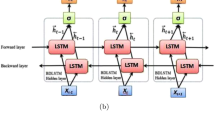Abstract
Forecasting volatility is an important issue in financial econometric analysis. This paper aims to seek a computationally feasible approach for predicting large scale conditional volatility and covariance of financial time series. In the case of multi-variant time series, the volatility is represented by a Conditional Covariance Matrix (CCM). Traditional models for predicting CCM such as GARCH models are incapable of dealing with high-dimensional cases as there are O(N 2) parameters to be estimated in the case of N-variant asset return, and it is difficult to accelerate the computation of estimating these parameters by utilizing modern multi-core architecture. These GARCH models also have difficulties in modeling non-linear properties. The widely used Restricted Boltzmann Machine (RBM) is an energy-based stochastic recurrent neural network and its extended model, Conditional RBM (CRBM), has shown its capability in modeling high-dimensional time series. In this paper, we first propose a CRBM-based approach to forecast CCM and show how to capture the long memory properties in volatility, and then we implement the proposed model on GPU by using CUDA and CUBLAS. Experiment results indicate that the proposed CRBM-based model obtains better forecasting accuracy for low-dimensional volatility and it also shows great potential in modeling for large-scale cases compared with traditional GARCH models.







Similar content being viewed by others
References
Bollerslev T, Engle R, Nelson D (1986) Arch models. In: Handbook of econometrics, vol 4, Elsevier, Amsterdam, pp 2959–3038
Bollerslev T (1986) Generalized autoregressive conditional heteroskedasticity. J Econom 31(3):307–327
de Oliveira M (2011) The influence of Arima-Garch parameters in feed forward neural networks prediction. Neural Comput Appl 20(5):687–701
Gavrishchaka VV, Banerjee S (2006) Support vector machine as an efficient framework for stock market volatility forecasting. Comput Manag Sci 3(2):147–160
Tang LB, Tang LX, Sheng HY (2009) Forecasting volatility based on wavelet support vector machine. Expert Syst Appl 36(2):2901–2909
Taylor G, Hinton G, Roweis S (2007) Modeling human motion using binary latent variables. Adv Neural Inf Process Syst 19:1345
Merton R (1980) On estimating the expected return on the market. 1. An exploratory investigation. J Financ Econ 8(4):323–361
Smolensky P (1986) Information processing in dynamical systems: foundations of harmony theory. In: Parallel distributed processing: explorations in the microstructure of cognition, vol 1, pp 194–281
Hinton G, Salakhutdinov R (2006) Reducing the dimensionality of data with neural networks. Science 313(5786):504
Sutskever I, Hinton G (2007) Learning multilevel distributed representations for high-dimensional sequences. In: Proceeding of the eleventh international conference on artificial intelligence and statistics, pp 544–551
Taylor G, Hinton G, Roweis S (2011) Two distributed-state models for generating high-dimensional time series. J Mach Learn Res 12:1025–1068
Hinton G (2002) Training products of experts by minimizing contrastive divergence. Neural Comput 14(8):1771–1800
Liu Y, Gopikrishnan P, Stanley H (1999) Statistical properties of the volatility of price fluctuations. Phys Rev E, Stat Nonlinear Soft Matter Phys 60(2):1390
Lockett AJ, Miikkulainen R (2009) Temporal convolution machines for sequence learning. Tech rep AI-09-04, Department of Computer Sciences, the University of Texas at Austin
Nvidia C (2007) Compute unified device architecture programming guide, vol 83, p 129. NVIDIA, Santa Clara
Nvidia C (2008) Cublas library, vol 15, NVIDIA, Santa Clara
Tsay R (2005) Analysis of financial time series, vol 543. Wiley-Interscience, New York
Watkins D (2002) Fundamentals of matrix computations. LibreDigital, vol 56
Ding Z (1996) Time series analysis of speculative returns. University of California, Department of Economics, San Diego
Bollerslev T (1990) Modelling the coherence in short-run nominal exchange rates: a multivariate generalized arch model. Rev Econ Stat 72(3):498–505
Acknowledgements
This work is supported in part by the National Natural Science Foundation of China under Grant No. 61073055, 985-III fund, and Natural Science Foundation of Guangdong Province, China, under Grant No. 10152104101000004.
Author information
Authors and Affiliations
Corresponding author
Rights and permissions
About this article
Cite this article
Cai, X., Lai, G. & Lin, X. Forecasting large scale conditional volatility and covariance using neural network on GPU. J Supercomput 63, 490–507 (2013). https://doi.org/10.1007/s11227-012-0827-1
Published:
Issue Date:
DOI: https://doi.org/10.1007/s11227-012-0827-1




